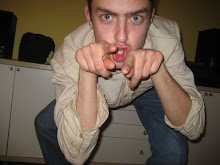Practice Essay
Hey all!
I wrote a practice essay to prepare for my english exam, and I like it so I thought I'd post it here.
Minor Characters and Symbolism in Fight Club
Throughout Fight Club, many of the characters provide symbolism. Aside from the two obvious characters (Jack, and Tyler Durden), these three characters all provide extra depth to the meaning of the plot.
The first, and perhaps most obvious example, is Robert Paulson, also known as Bob. As Jack states in one of the first lines: "This is Bob. Bob has bitch-tits." Bob is a victim of testicular cancer, and thus has an irregular amount of estrogen in his body, giving him breasts. Bob was previously a body-builder, and is the first to die for the cause with which he is affiliated. Bob represenst the feminine qualities of all men, particualarly those men who are obsessed with masculinity. Bob is one of the strongest fighters in the fight club, and is arguably one of the most intimidating characters next to Lou (who I'll get to later), yet he is also the most feminine male character. This makes the point that even the toughest men have a trace of feminity in them (albeit in a more obvious way than normal). The fact that Bob is the nicest, and most innocent, and yet the first to die suggests that the one to pay for the crimes committed is the person who least deserves punishment. This parallels civilian casualties in war.
Angel Face, Jared Leto's character who has his face destroyed by Jack, represents another kind of innocent casualty. The fact that Angel Face is the youngest, and least intimidating member of Project Mayhem suggests that he is simply trying to grow up. His face injury represents lessons learned in order to mature. It is interesting to point out that during his transformation, he goes from a being a social prisoner (childhood), to a man who thinks he is free of oppression (young adulthood), to another kind of prisoner, even more opressed than at the start but not realizing it (adulthood, career). Ironically, the third stage of his development is a stronger form of what he went to fight club to escape in the first place.
Lou, the owner of the tavern who attempts to end fight club, and is subsequently splattered by Tyler’s blood and intimidated into giving up, represents government. Lou goes to destroy a program which hasn’t affected him at all yet, believing that it will in some way harm him. Lou brings force (his bodyguard/goon, representing the army) to intimidate the people to do as he says. Tyler Durden, representing the opposing force, or terrorist to Lou’s government, defeats Lou in a dirty and unconventional way. This represents guerrilla warfare. The entire segment with Lou is to show that Tyler’s commitment to his cause will not be stopped by even the most powerful of forces.
In short, many of the themes of the film can be seen in these three characters. Although on a more obvious level these characters seem to not be needed by the plot, when you consider the symbolism, these characters keep the idea going. The story needs them to successfully use the themes present.


0 Comments:
Post a Comment
<< Home